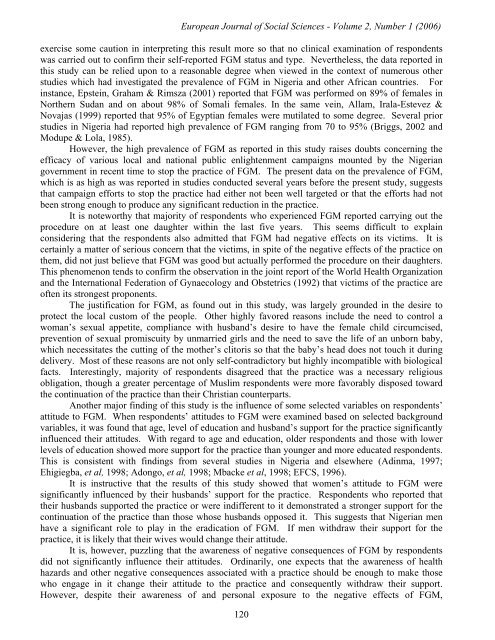EFFECT OF VITAMINS C AND E INTAKE ON BLOOD ... - EuroJournals
EFFECT OF VITAMINS C AND E INTAKE ON BLOOD ... - EuroJournals
EFFECT OF VITAMINS C AND E INTAKE ON BLOOD ... - EuroJournals
Create successful ePaper yourself
Turn your PDF publications into a flip-book with our unique Google optimized e-Paper software.
European Journal of Social Sciences - Volume 2, Number 1 (2006)<br />
exercise some caution in interpreting this result more so that no clinical examination of respondents<br />
was carried out to confirm their self-reported FGM status and type. Nevertheless, the data reported in<br />
this study can be relied upon to a reasonable degree when viewed in the context of numerous other<br />
studies which had investigated the prevalence of FGM in Nigeria and other African countries. For<br />
instance, Epstein, Graham & Rimsza (2001) reported that FGM was performed on 89% of females in<br />
Northern Sudan and on about 98% of Somali females. In the same vein, Allam, Irala-Estevez &<br />
Novajas (1999) reported that 95% of Egyptian females were mutilated to some degree. Several prior<br />
studies in Nigeria had reported high prevalence of FGM ranging from 70 to 95% (Briggs, 2002 and<br />
Modupe & Lola, 1985).<br />
However, the high prevalence of FGM as reported in this study raises doubts concerning the<br />
efficacy of various local and national public enlightenment campaigns mounted by the Nigerian<br />
government in recent time to stop the practice of FGM. The present data on the prevalence of FGM,<br />
which is as high as was reported in studies conducted several years before the present study, suggests<br />
that campaign efforts to stop the practice had either not been well targeted or that the efforts had not<br />
been strong enough to produce any significant reduction in the practice.<br />
It is noteworthy that majority of respondents who experienced FGM reported carrying out the<br />
procedure on at least one daughter within the last five years. This seems difficult to explain<br />
considering that the respondents also admitted that FGM had negative effects on its victims. It is<br />
certainly a matter of serious concern that the victims, in spite of the negative effects of the practice on<br />
them, did not just believe that FGM was good but actually performed the procedure on their daughters.<br />
This phenomenon tends to confirm the observation in the joint report of the World Health Organization<br />
and the International Federation of Gynaecology and Obstetrics (1992) that victims of the practice are<br />
often its strongest proponents.<br />
The justification for FGM, as found out in this study, was largely grounded in the desire to<br />
protect the local custom of the people. Other highly favored reasons include the need to control a<br />
woman’s sexual appetite, compliance with husband’s desire to have the female child circumcised,<br />
prevention of sexual promiscuity by unmarried girls and the need to save the life of an unborn baby,<br />
which necessitates the cutting of the mother’s clitoris so that the baby’s head does not touch it during<br />
delivery. Most of these reasons are not only self-contradictory but highly incompatible with biological<br />
facts. Interestingly, majority of respondents disagreed that the practice was a necessary religious<br />
obligation, though a greater percentage of Muslim respondents were more favorably disposed toward<br />
the continuation of the practice than their Christian counterparts.<br />
Another major finding of this study is the influence of some selected variables on respondents’<br />
attitude to FGM. When respondents’ attitudes to FGM were examined based on selected background<br />
variables, it was found that age, level of education and husband’s support for the practice significantly<br />
influenced their attitudes. With regard to age and education, older respondents and those with lower<br />
levels of education showed more support for the practice than younger and more educated respondents.<br />
This is consistent with findings from several studies in Nigeria and elsewhere (Adinma, 1997;<br />
Ehigiegba, et al, 1998; Adongo, et al, 1998; Mbacke et al, 1998; EFCS, 1996).<br />
It is instructive that the results of this study showed that women’s attitude to FGM were<br />
significantly influenced by their husbands’ support for the practice. Respondents who reported that<br />
their husbands supported the practice or were indifferent to it demonstrated a stronger support for the<br />
continuation of the practice than those whose husbands opposed it. This suggests that Nigerian men<br />
have a significant role to play in the eradication of FGM. If men withdraw their support for the<br />
practice, it is likely that their wives would change their attitude.<br />
It is, however, puzzling that the awareness of negative consequences of FGM by respondents<br />
did not significantly influence their attitudes. Ordinarily, one expects that the awareness of health<br />
hazards and other negative consequences associated with a practice should be enough to make those<br />
who engage in it change their attitude to the practice and consequently withdraw their support.<br />
However, despite their awareness of and personal exposure to the negative effects of FGM,<br />
120
















